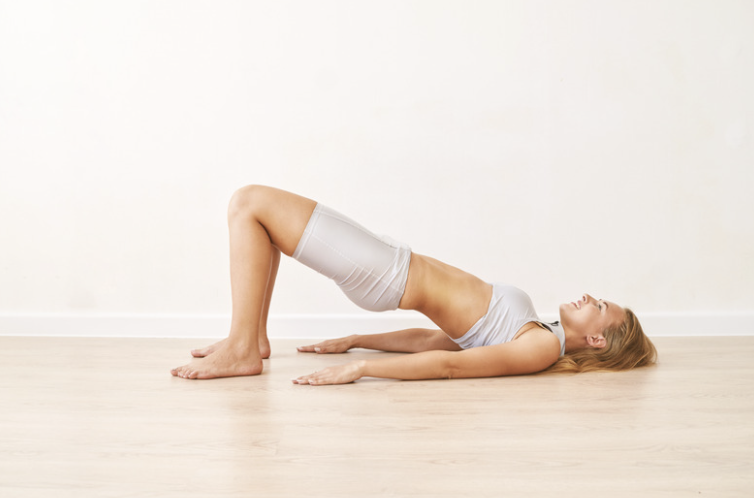Your pelvic floor is like a hammock made up of muscles, ligaments and other tissues that stretch from your pubic bone to your backbone. Along with your ab muscles, the pelvic floor helps support your bowels, uterus, and bladder.
But just like the rest of your body, your pelvic floor can weaken or become damaged with age and life events like pregnancy, childbirth, injury or menopause.
This can lead to issues like urinary incontinence because the pelvic floor muscles play a crucial part in bladder control.
Whether you leak a little when you laugh or find yourself suddenly running to the loo every time you step through your front door, it might be a sign that your pelvic floor needs some love.
Luckily, you can strengthen your pelvic floor muscles with easy exercises you can do from the comfort of your own home.
Don’t know where to start? Keep reading for a beginner’s guide to strengthening your pelvic floor muscles to reduce bladder leaks.
When should you start doing pelvic floor exercises?
Everyone (regardless of age, gender, or general health) should be exercising their pelvic floor muscles, the sooner the better!
Many people go through their adult life with backache from poor posture, very little body awareness around pelvic floor and unnecessary suffering – physically, emotionally and mentally – because we aren’t taught about it, or the value of [the pelvic floor],” says pelvic floor specialist Charlotte Wise.
For many women, issues in pregnancy or postnatally are the red flag that sparks an awareness of this area, but we could do so much preventatively with a little education. We are using these muscles when we breathe, go to the toilet, laugh, cough or sneeze. We are using them from day 1 – we should be aware of them throughout our whole life.”
If you’re thinking it’s too late for you, don’t worry – it’s never too late to start doing pelvic floor exercises.
In fact, if you’re already dealing with bladder leaks it’s even more reason to incorporate pelvic floor strengthening into your daily routine.
How to do pelvic floor exercises
So now that we know just how important it is to train your pelvic floor muscles, how exactly do we do that? Luckily, you won’t need any fancy equipment or vigorous training.
Follow this beginner-friendly visualisation exercise from Wise to help you find, contract and relax your pelvic floor:
- Start by sitting upright on the edge of a firm chair so that your spine is long and tall, and you can feel your sitting bones on the seat beneath you.
- Place your fingertips on your hip bones and slide them just an inch inside the hip bones and then down an inch. Continue to press gently here to feel feedback as to when you are contracting your pelvic floor muscles. If you cough gently whist your fingertips rest here, you will feel a ‘flicker’ of response in the muscles – this is where you are aiming to feel contraction as you engage your pelvic floor muscles!
- Breath in and out steadily for several breaths. On your exhale, begin to lift your pelvic floor muscles. To do this visualise an elevator, an internal lift shaft. As you breathe out you are trying to lift this elevator up through the vagina, contracting and lifting the muscles that sit in the base of the pelvis. You are visualising the lift pulling up from the ground floor (the base of the pelvis, or the seat you are aware of sitting on) up through the first floor, up through the second floor – as much as you feel you can contract, and then feel that you control the release of this contraction. Try to avoid squeezing your buttock muscles or leg muscles. Try not to lift your torso and relax your upper body. Your body will likely try to recruit other muscles besides those you are trying to activate but less is more – this will feel very subtle, and you shouldn’t see your body move, it is an internal connection.
- It can take practice to feel this connection but work with this until you feel you have a connection here and, when confident, add a second contraction.
- Your fingertips are resting as before just inside and a little lower than your hip bones. Visualise a line across the lower abdomen between your fingertips. As you breathe out you are going to lift through the pelvic floor (as above) and then hollow in along this line between your fingertips. Imagine a belt sitting on your hip bones — you are hollowing these muscles in as if you are fastening the belt a notch too tight.
- Your intention is to combine these contractions so that they merge, they feel like one connection. The pelvic floor lifts internally and then you hollow in between the hipbones as if tightening your belt. This happens as you are exhaling; on your inhale you relax these muscles.
These two contractions together form a strong and stable base for working our pelvic floor. Additional exercises can be added,” says Wise. You can work at differentiating muscles within this area and contracting these muscles at varying speeds, but this is the foundation on which all your pelvic floor work will rest.”
Other exercises great for your pelvic floor
Once you’ve mastered the above, it can be helpful to incorporate other pelvic floor-friendly exercises into your workout routine.
Whilst the pelvic floor is an area we can isolate to contract independently within the body, in reality, nothing in the body functions in isolation,” says Wise.
She explains that while pelvic floor exercises like Kegels can teach you how to isolate your pelvic floor muscles, there are plenty of other exercises you can do to strengthen your pelvic floor – like pilates, inner thigh work, and running.
We are able to use or work our pelvic floor in so many of the activities we do daily because it works synergistically with our whole core, and the pelvic floor also responds to unconscious work via our myofascial system,” she says.
Pilates is a great exercise modality as we are synergistically working our pelvic floor as we are targeting any aspect of our core.” Your core is made up of your pelvic floor, abdominals muscles, diaphragm and back muscles.
Our adductors (our inner thigh muscles) attach into the pelvic floor area so any time we are working them, loading or moving them we can be activating our pelvic floor. Running will strengthen our pelvic floor if we have a strong and stable core that we are recruiting functionally whilst we run.”
We know bladder leaks can sometimes be triggered by jumping or running (known as stress incontinence), so it can feel daunting to incorporate these movements at first. But you should still aim to move your body daily because it can help in the long run – just start slow!
Just a few minutes of pelvic floor training a day can have amazing benefits. It may take a while to notice results, but we promise you won’t regret it!
This feature blog post was written by our amazing partners at Jude!







